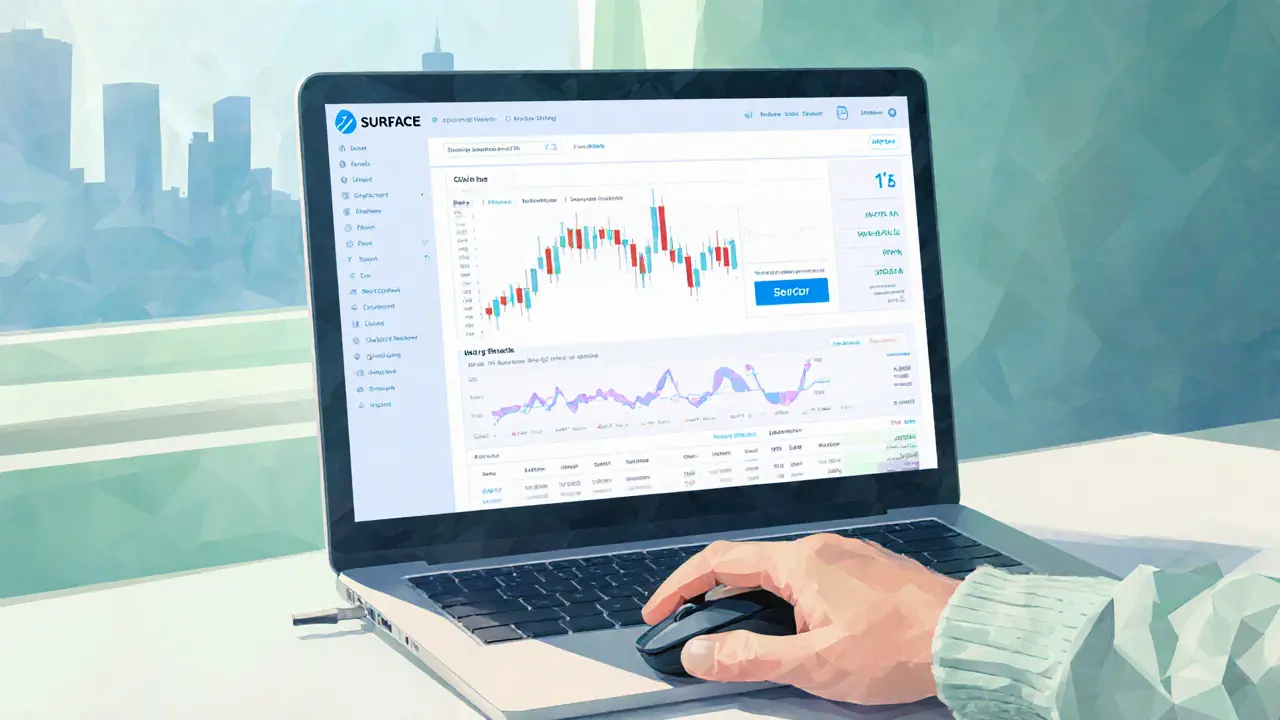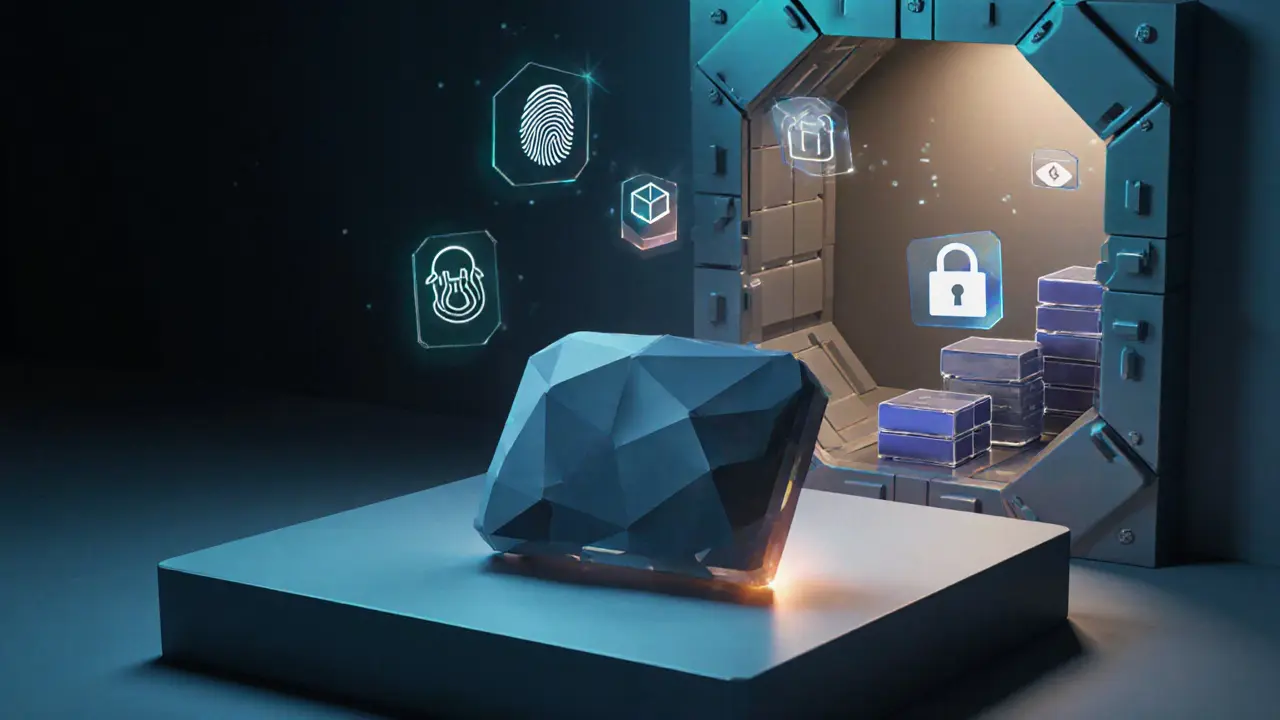Surface Crypto Exchange Review 2025 - In‑Depth Look

Surface Crypto Exchange Fee Calculator
Fee Breakdown
Maker Fee: 0.12%
Taker Fee: 0.25%
Estimated Monthly Fees: $0.00
Estimated Annual Fees: $0.00
How it works: Surface uses a tiered fee structure. Based on your estimated monthly trading volume, your fees will adjust accordingly. Higher trading volumes result in lower fees.
Surface Fee Structure Overview
| Monthly Volume | Maker Fee | Taker Fee |
|---|---|---|
| Below $100,000 | 0.12% | 0.25% |
| $100,000 - $500,000 | 0.10% | 0.22% |
| Above $500,000 | 0.08% | 0.20% |
How Surface Compares to Other Exchanges
Binance
Maker: 0.10%, Taker: 0.12%
Lowest fees in the marketCoinbase
Maker: 0.50%, Taker: 0.50%
Higher fees but user-friendlyKraken
Maker: 0.16%, Taker: 0.26%
Mid-tier fees with strong securityKey Takeaways
- Surface targets both beginners and seasoned traders with a clean UI and advanced tools.
- Fees start at 0.12% maker and 0.25% taker, slightly higher than Binance but lower than Coinbase.
- Security relies on hardware‑wallet‑grade cold storage, SOC2 TypeII certification, and mandatory 2FA.
- Regulated in the UK (FCA) and Australia (ASIC), giving U.S. users a compliant gateway.
- Features include staking, NFT marketplace, copy‑trading, and a growing suite of DeFi integrations.
Trying to pick a crypto exchange can feel like choosing a bank, a broker, and a gaming platform all at once. With dozens of options, the biggest question is whether a newer player can actually compete with giants like Binance, Coinbase, or Kraken. This review cuts through the hype and tells you exactly how Surface crypto exchange performs in 2025 - from fees and security to the everyday experience of buying, selling, and earning on the platform.
What Is Surface?
When you hear the name Surface is a cryptocurrency exchange launched in early 2024 that aims to blend the simplicity of a beginner‑friendly broker with the depth of a professional trading hub, you might wonder if it’s just another copycat. In reality, Surface positions itself as a “crypto‑first bank” - a single‑pane‑of‑glass where you can trade spot assets, stake coins, buy NFTs, and even tap into DeFi protocols without leaving the app.
Surface’s headquarters sit in London, and it holds a Full‑FCA license as well as an ASIC registration in Australia. The exchange reports that, as of Q22025, it has attracted 2.8million registered users and holds roughly $4.3billion in assets under custody. That may sound modest next to eToro’s $16.6billion, but the growth rate - double‑digit month‑over‑month - suggests a platform gaining real traction.
Core Features Compared to the Competition
Below we break down the most common reasons people choose an exchange and see how Surface measures up against the heavyweights.
Fees
Surface uses a tiered fee model that mirrors the industry standard: the more you trade, the less you pay. For most retail traders, fees sit at 0.12% maker and 0.25% taker. If you push over $100,000 in 30‑day volume, the maker fee drops to 0.08% and the taker to 0.20%.
By comparison, Binance offers some of the lowest fees in the market, starting at 0.10% maker and 0.12% taker, with further discounts for BNB holders. Coinbase charges higher spreads, typically 0.50% to 4% depending on trade size and payment method. So Surface lands comfortably between the low‑fee champion Binance and the higher‑cost Coinbase, making it a sensible middle ground.
Security
Security is non‑negotiable. Surface stores 98% of user funds in offline, hardware‑wallet‑grade cold storage, and the remaining 2% sits in multi‑sig hot wallets for instant withdrawals. The platform passed a SOC2 TypeII audit in March2025 and employs mandatory 2FA, biometric login, and IP‑whitelisting for API keys.
Looking at peers: Kraken is renowned for its rigorous security protocols and has never suffered a major breach. Gemini offers a similar cold‑storage approach and holds a NYDFS trust charter for added regulatory weight. Surface’s security stack lines up well with these industry leaders, though it hasn’t yet earned the same reputation built over a decade.
Asset Variety
Surface lists 150 spot cryptocurrencies, covering the top 100 by market cap and a curated selection of emerging altcoins. It also provides tokenized stocks and a small but growing NFT marketplace. Binance still leads with over 200 pairs and deep DeFi integrations, while eToro restricts itself to about 130 tokens.
Trading Tools
For power users, Surface offers advanced charting (integrated with TradingView), limit/stop orders, and a sandbox API for algorithmic traders. The “Copy‑Trader” module lets newbies mirror top‑performing strategies - a feature first popularized by eToro and now re‑imagined with AI‑driven risk filters on Surface.
If you need futures or options, Binance is still the go‑to (especially in Europe and the UK). Kraken offers futures in the U.S. and a robust margin system, while Surface is currently rolling out futures for select pairs in Q42025.
Mobile Experience
The Surface app is built on React Native, delivering a fast, native feel on both iOS and Android. Users praise its intuitive navigation, one‑tap staking, and push notifications for price alerts. Coinbase’s app remains a benchmark for simplicity, whereas Binance’s app can feel cluttered with advanced options.
Customer Support
Surface provides 24/7 live chat, email ticketing, and a community Discord channel staffed by product engineers. Average response time is under three minutes for chat and 24hours for email. This beats many older platforms that still rely on ticket‑only support.
Regulatory Landscape
Surface’s dual licensing with the FCA means it complies with the UK’s strict anti‑money‑laundering and consumer protection rules and the ASIC covers Australian financial services standards, including segregation of client funds. This clears a hurdle for U.S. users who often avoid exchanges without clear regulatory status, giving Surface a competitive edge over unregistered platforms.

Side‑by‑Side Comparison
| Feature | Surface | Binance | Coinbase | Kraken | eToro |
|---|---|---|---|---|---|
| Founded | 2024 | 2017 | 2012 | 2011 | 2007 |
| Regulatory licences | FCA, ASIC | None (global), limited US | FinCEN, NYDFS | FinCEN, FCA | FCA, CySEC, ASIC |
| Spot assets | 150+ | 200+ | 115 | 200+ | 130 |
| Maker fee (base) | 0.12% | 0.10% | 0.50% | 0.16% | 0.15% |
| Taker fee (base) | 0.25% | 0.12% | 0.50% | 0.26% | 0.20% |
| Staking options | 15+ tokens, up to 12% APY | 20+ tokens, up to 15% APY | 5 tokens, up to 5% APY | 12 tokens, up to 10% APY | 7 tokens, up to 8% APY |
| Copy‑trading | AI‑filtered, live feed | None (social feed only) | None | None | Built‑in CopyTrader |
| Mobile app rating (iOS/Android) | 4.6 / 4.5 | 4.4 / 4.2 | 4.5 / 4.3 | 4.3 / 4.2 | 4.2 / 4.1 |
| Customer support (avg response) | Live chat <3min | Email 24h | Ticket 48h | Live chat 10min | Live chat 5min |
Who Should Use Surface?
Beginners - If you’re just dipping a toe, Surface’s clean dashboard, built‑in tutorials, and copy‑trading help you learn without feeling lost. The platform also offers a $100‑worth crypto welcome bonus for new accounts that complete a first trade, a perk you won’t find on Kraken or Binance.
Intermediate traders - Those looking to add staking, NFTs, or DeFi swaps will appreciate the one‑stop shop. The tiered fee schedule rewards higher volume, so if you trade a few thousand dollars a month you’ll see real savings versus Coinbase’s flat spread.
Advanced users & institutions - While Surface lacks the deep futures suite of Binance, it does provide a sandbox API, customizable dashboards, and institutional‑grade custody. If you need a regulated gateway with FCA backing, Surface can be a safer alternative to unlicensed offshore platforms.
Pros and Cons at a Glance
- Pros:
- Regulated in two major jurisdictions (FCA, ASIC).
- Mid‑range fees that soften as you trade more.
- Robust security - cold storage + SOC 2 Type II.
- AI‑enhanced copy‑trading for newcomers.
- All‑in‑one mobile experience (spot, staking, NFTs).
- Cons:
- Futures and options still in beta.
- User base smaller than Binance, so liquidity on tiny altcoins can lag.
- No U.S. state‑by‑state licensing yet, limiting access for some American users.

How to Get Started on Surface
- Visit the official Surface website and click “Sign Up”.
- Enter your email, create a strong password, and verify via the link sent to your inbox.
- Complete KYC - upload a government ID and proof of address. The process usually clears within 10minutes.
- Enable two‑factor authentication (Google Authenticator or SMS).
- Deposit funds. You can fund via bank transfer (FCA‑regulated), credit/debit card, or crypto deposit from an external wallet.
- Claim the $100 welcome crypto bonus by purchasing any asset worth at least $50 within the first 7days.
- Explore the “Learn” tab - watch short videos on how to place limit orders, stake ETH, or join the copy‑trading feed.
- Start trading! Begin with a modest position, set stop‑losses, and watch the market.
Troubleshooting Common Issues
Deposit not showing up - Double‑check the blockchain transaction hash. Surface’s custodial wallet uses a 12‑hour confirmation window for large sums. If it’s still missing, open a live‑chat ticket - the support team can trace the txID.
Unable to verify identity - Ensure the ID photo is clear, your name matches the address proof, and the files are under 5MB. Blurry scans are the most frequent cause of rejections.
High fees on small trades - Surface applies a minimum fee of $1 on trades under $100. To keep fees low, bundle small purchases into a single larger order.
Frequently Asked Questions
Is Surface safe for long‑term crypto storage?
Yes. Surface stores 98% of user funds in offline, hardware‑wallet‑grade cold storage, undergoes SOC2 TypeII audits, and is regulated by the FCA and ASIC, which require strict segregation of client assets.
How do Surface’s fees compare to Binance?
Surface’s base maker/taker fees are 0.12%/0.25%, slightly higher than Binance’s 0.10%/0.12%. However, Surface offers a tiered discount that can bring fees below Binance’s rates once you exceed $100k in 30‑day volume.
Can I trade futures on Surface?
Futures are in a beta rollout for a limited set of major pairs, expected to go live globally in Q42025. Until then, you can use spot trading and staking.
What’s the minimum withdrawal amount?
Withdrawals start at $10 for fiat and 0.001BTC (or equivalent) for crypto. Larger amounts may require additional verification steps.
Does Surface support US customers?
Surface accepts US users but compliance varies by state. Residents of New York and California must complete an additional “Enhanced KYC” process before trading.

Andrew Lin
October 8, 2025 AT 08:16Surface is just another cash‑grab for the elite, think they’re slick but they’re overcharging us. If you want real low fees, stick with Binance.
Richard Bocchinfuso
October 9, 2025 AT 08:09Trading platforms should be transparent about how they handle user funds, otherwise it’s exploitation.
Melanie LeBlanc
October 10, 2025 AT 08:02Nice breakdown! The tiered fee structure makes it easy for newcomers to understand when they’re saving money.
Don Price
October 11, 2025 AT 07:56There’s something uneasy about any exchange that claims full regulatory compliance while still keeping the bulk of its operations hidden behind vague “FCA” and “ASIC” mentions. The reality is that most of these licences are paper‑only, designed to give a false sense of security. In 2023 we saw a wave of “shadow exchanges” that were technically registered but never actually subjected to proper audits. Surface’s claim of 98% cold storage sounds good, but who is verifying those numbers? The SOC2 TypeII audit they brag about is a mere checklist and not a guarantee against insider theft. Moreover, the crypto‑first bank narrative is a marketing ploy to lure users who think they’re getting bank‑level protection. Remember the case of XYZ Exchange in 2022 where the audit turned out to be fabricated? That precedent should make any cautious trader nervous. Their AI‑driven copy‑trading feature also opens a vector for manipulation, as bots can be programmed to pump and dump under the radar. The fact that they have a Discord staffed by engineers is cute, but it’s also an avenue for coordinated misinformation campaigns. If you look at the token listings, many are low‑cap projects that could vanish overnight, and Surface’s “curated” list is subjectively chosen, not objectively vetted. The fee structure, while modest, still benefits the platform more as volume scales, creating a hidden profit model. Finally, the claim of being regulated in the UK and Australia doesn’t protect US users, who are left in a legal gray area. All this points to a platform that is trying to appear legitimate while still operating in the shadows of the crypto world.
Jasmine Kate
October 12, 2025 AT 07:49Wow, Surface’s UI is glossy, but the hidden fees will bite you harder than a shark!
Mark Fewster
October 13, 2025 AT 07:42The cold‑storage ratio of 98% appears solid; however, regular audits would reinforce confidence.
Dawn van der Helm
October 14, 2025 AT 07:36👍 Looks like Surface is stepping up its game, especially with that copy‑trading AI! 🚀
Monafo Janssen
October 15, 2025 AT 07:29Surface tries to bridge the gap between beginner simplicity and pro‑level tools, which is a welcome direction. Their mobile app feels snappy and the one‑tap staking is convenient. It’s also good to see a platform that respects regional regulations rather than ignoring them. Still, the ecosystem could benefit from more educational resources for newcomers.
Michael Phillips
October 16, 2025 AT 07:22When evaluating an exchange, it helps to consider the philosophical trade‑off between openness and security. Surface leans toward openness with its DeFi integrations, yet keeps a tight security perimeter. That balance might appeal to users who want flexibility without sacrificing safety.
Jason Duke
October 17, 2025 AT 07:16Really appreciated the earlier point about transparency. It’s crucial that platforms keep users informed about fee changes, especially as volume thresholds shift. Surface’s tiered model is clear, but ongoing communication will keep trust high.
Franceska Willis
October 18, 2025 AT 07:09That glossy UI? Just a distraction. When you dig into the fine print, you’ll discover extra charges for withdrawals that aren’t shouted about in the marketing materials.
Matthew Laird
October 19, 2025 AT 07:02All that talk about conspiracies ignores the fact that many users actually enjoy the convenience Surface offers. Not every new exchange is a trap; sometimes innovation simply means a fresh approach to regulation and user experience.
Patrick Gullion
October 20, 2025 AT 06:56Sure, the UI looks cool, but the real test is whether the API reliability holds up for serious traders. I’ve seen newer platforms stumble there.
Mark Bosky
October 21, 2025 AT 06:49From a compliance standpoint, Surface’s dual licensing with the FCA and ASIC provides a solid regulatory foundation, particularly for users outside the United States. Their segregation of client funds aligns with best practices observed in traditional finance, and the inclusion of SOC2 TypeII audits adds an extra layer of assurance. Nonetheless, prospective traders should monitor ongoing audit reports to ensure continued adherence to these standards.
Debra Sears
October 22, 2025 AT 06:42Overall, Surface looks promising for mid‑level traders.